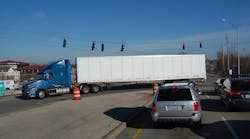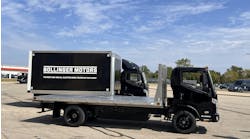Cost and complexity the main challenges facing “next-stage” fuel efficiency rules
The "next-stage" fuel efficiency rules announced by President Obama in a speech yesterday will require complex solutions in order to achieve, according to a range of experts – a complexity that will also come with an as-yet to be determined price tag as well.
The Owner-Operator Independent Drivers Association (OOIDA) in particular is concerned that cost to comply with the new “post-2018” fuel efficiency rules will further drive up the price of new trucks, pointing out that “first-stage” fuel efficiency mandates crafted in 2011 by the Environmental Protection Agency (EPA) and National Highway Traffic Safety Administration (NHTSA) added as much as $6,200 to the sticker price of model year 2014-2018 trucks covered by those standards.
“The standards will continue to push the cost of new trucks skyward, thereby forcing many small-business truckers and fleet owners to hold onto older trucks and put off buying new equipment as long as they can,” noted Todd Spencer, OOIDA’s executive VP, in a statement.
OOIDA pointed to a fact sheet released by the White House yesterday to illustrate some of the potentially costly technology that could deployed to meet the as-yet-unwritten “post-2018” rules, including: improvements to engines and powertrains; aerodynamics; weight reductions; lower rolling resistance; hybridization; automatic engine shutdown; plus accessory improvements for fans, auxiliary power units, air conditioning, etc.
“Many of these technologies are not yet in production and most would have impacts on specialized trucking operations,” Spencer said. “’Shock and awe’ may be the best way to describe what’s happening to the vast majority in trucking with these proposed regulations.”
However, others believe that long-term the “post-2018” fuel efficiency mandates should work out in the industry’s favor.
“While it presents short-term pain for the industry, the President's decision to elevate fuel efficiency standards for medium and heavy-duty trucks is definitely a strategic move [that] will indeed deliver long-term gain both locally and globally,” noted Sandeep Kar, global automotive and transportation research director for worldwide consulting firm Frost & Sullivan.
“Trucks featuring better fuel-efficiency and economy will cost higher than the current breed of trucks, but will deliver reduced fuel expenses for fleets thereby reducing life-cycle costs and hence total cost of ownership, while simultaneously reducing freight transportation's carbon footprint,” he said.
“Fuel costs have already become the most expensive portion of a fleet's operating expenses, and any change that reduces fuel costs in a volatile fuel price environment will be welcomed by the end-users,” Kar emphasized. “While these mandates will challenge OEMs and tier-1 suppliers, I feel that this is not an insurmountable challenge and one that will pay rich dividends to all corners of the American trucking industry."
Allen Schaeffer, executive director of the Diesel Technology Forum (DTF), told Fleet Owner that it’s critical not to discount that engineering challenges posed by the “post-2018” fuel efficiency effort.
“The number of engineering variables involved numbers in the millions,” he explained. “These rules will be complex and will reinforce the need for better integration between all the components of a tractor-trailer.”
Schaeffer added that enhancements to the powertrain of today’s modern truck – the engine and transmission, what he dubbed “the heart and lungs” of a commercial vehicle – will be critical to making these future fuel efficiency rules work. “They will be the central key around which other changes will be made,” he said.
Schaeffer also thinks that while by necessity the number of chassis choices and truck options will decline in order for cohesive gains in fuel efficiency to be achieved, it will also allow vehicles to be “matched” better to the final operating characteristics demanded of them – all while delivering better fuel economy.
“These rules don’t represent a ‘paradigm’ shift away from performance-based standards – there will still be a lot of options available to design the best vehicles to meet these standards, rather than mandating certain technologies to get there,” he emphasized.
Patrick Quinn, a consultant with the Accord Group that is heading up the Heavy Duty Fuel Efficiency Leadership Group (HDFELG), pointed out to FleetOwner that these “next stage” rules will also involve trailers for the first time. That's because the mandate requires the involvement of the California Air Resources Board (CARB), which already regulates trailers frm a fuel-efficiency perspective.
Quinn said one of the reasons HDFELG provides what he called a ‘cross sector’ viewpoint of the industry – involving fleets such as Con-Way and FedEx, trailer maker Wabash Corp., engine maker Cummins, and transmission supplier Eaton – is that “long-term” certainty will be needed from any fuel efficiency rules package so OEMs, suppliers and fleets alike can make better strategic plans for the future.
“For example, what will be a reasonable rate of return for equipment investment? Will 18 months be realistic for fleets, for example? Answering that question will be much harder that it was for the first phase of the fuel efficiency mandates,” Quinn explained. “Fuel as a percentage of operating cost is still unacceptably high for trucks, so this is a big opportunity to get aggressive with potential fuel savings.”
Yet DTF’s Schaeffer warned that it won’t be easy, by any means.
Indeed, the changeover to trucks compliant with current emission reduction and fuel saving mandates has been relatively slow with 2.86 million of the 8.8 million heavy duty trucks in the U.S. (32.5%) meeting first-generation clean diesel standards for model year 2007 engines, according to DTF, with only 1.29 million (14.7%) meeting the even more stringent clean diesel standards for 2010 and later model year engines.
“Let’s not kid ourselves; this is complicated stuff. A huge amount of resources will be needed just for the analytical and engineering phase of these new rules,” he said. “But I am confident that it will all lead to a good outcome.”



